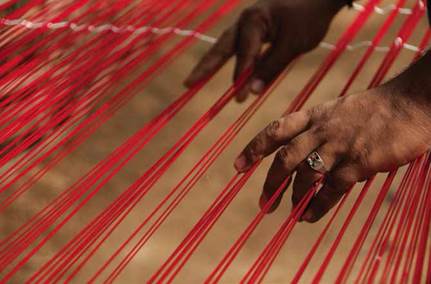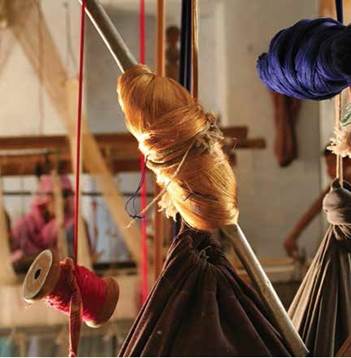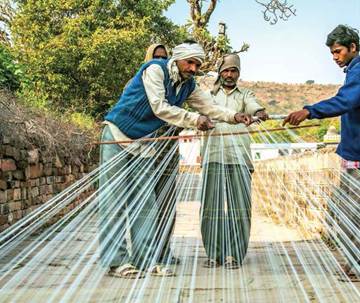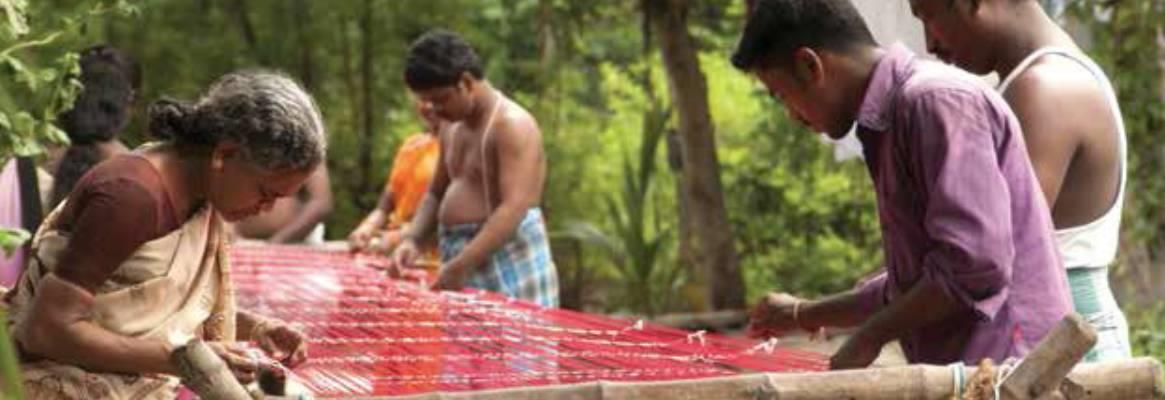India’s handloom base is captive capital which can transform production in the textiles sector and position the country as a pioneer in global garment manufacturing processes which are energy-efficient, carbon negative and perhaps the world’s largest generator of community employment via cluster enterprise.
The Weyl cat Pegasus is neither a feline with an exotic surname nor is it a mythical monster. The Weyl cat Pegasus is a powerful catalysing agent which works with the hydrogen peroxide used to bleach cotton, to reduce the temperature at which the bleaching process is conducted at textile factories. At an average reduction of almost 25 degrees per process, it was estimated that more than 118 metric tonnes of CO2e emission, was saved in 2019.
The apparel industry emits 3.2 billion tonnes of CO2e annually, which is 10 per cent of the global carbon emissions and more than 20 per cent of wastewater in addition to 93 million metres of textile waste. While the environmental impact of the airline industry is well known, the fashion industry guzzles more energy than aviation and shipping combined. Carbon-neutrality takes into account strict benchmarks related to effluence free manufacturing, fertiliser free crop cultivation and 100 per cent water recycling to conserve ground water levels and most importantly, the tenets of buy, conserve and compost.

Textile machinery used in the production of made-ups and fabric is one of the most known and prolific polluters in the world, accounting for a lion’s share of the 1.2 billion tonnes of GHG emission per annum globally. Several full lifecycle assessments of apparel and accessories have been undertaken globally and the one compelling factor which is a common denominator in every risk assessment analysis (RAA) is that prevention andro-active work across each and every point in the production process flow should be a de rigueur to reduce the environmental load, which is hurtling inexorably towards a horizon of carbon disaster by 2030.
The quest for carbon neutrality in the sustainable and fashion businesses is a bit of a conundrum. If manufacturing is scaled down, facilities will burn cash to sustain, but carbon footprint will be diluted. If manufacturing is scaled up and kept at a constant, carbon footprint will be bought in the shape and form of carbon credits which is more of a post facto action analysis and does not really contribute to preventive action. The solution lies in carbon light manufacturing processes, which can control the pace of fast fashion by creating sustainable fabric and made-up which can be worn more than 16 times. It has been seen that extending the life span of a garment by 8–9 months can actually reduce the Carbone mission by 20–22 per cent. A carbon-light manufacturing process could be a super complex, Io driven and maintained matrix of ultramodern machinery which can be run by a maze of AI-driven algorithms. It could be scalable but in legacy environments with a pre-set bunch of parameters. Given the technology prevalent in the times that we exist, the above would be a developer’s dream.
Handloom sector as readymade infrastructure
However, we can choose to step back and ponder for a moment: could we harness an existing set of manufacturing tools with technology which could create fabric and made ups in a process flow that would generate employment via enterprise in almost every nation which is notorious for its sweatshop manufacturing? Could we create skill shop economies in these small countries with clean energy driving machines to produce merchandise? Can we recycle the effluence generated in liquid or semi solid form into water for sanitation? The tenets of such a process can be found in India, which has a vast network of more than 6.6 million villages which work on handlooms, motor-driven looms which are run on kerosene generators in the event of power outage, and pure power looms which are run on almost any source of power—from Honda gensets to crude generators.
A typical hand loom is often” accused” of temperamental brilliance—meaning it can create weight less fabrics like muslin but cannot produce “even” fabric owing to the human hand being a slave differing to energy levels. Research in this country has shown that an average handloom can produce 5x of its current output per day if outfitted with AI. India has around 2.75 million handlooms in the country and the average handloom household was earning ₹5,000 in 2019–20 (4th All India Handloom Census) while the total number of handloom households was 3.17 million. Consider this as captive capital which can virtually transform production in the textiles sector and position India as a pioneer in global garment manufacturing processes which are energy-efficient, carbon negative and perhaps the world’s largest generator of community employment via cluster enterprise.
Going back to our artificially intelligent handloom, the Ranmir Foundation is working on a research which aims to transform it into a solar powered intelligent handloom. Amongst the array of things that this chipset can do is set shuttle speed, variation and changing gaps. The shuttle is the brain of the loom, which decides the cosiness of the reed and the pick—simple markers which determine the quality of the fabric.

Says Atanu Roy Chowdhury, a veteran solutions architect who heads the core team spearheading this research, “We are transforming the handloom into an energy-efficient machine, which can operate under 100 watts of power from a clean source. India being a tropical country with sufficient irradiation in most parts of the country, for most of the year, the handloom thus becomes a leitmotif of carbon neutral manufacturing which is scalable and sustainable.”
He adds, “We are looking at creating a pay-per-use ecosystem in this sector, where instead of micro-financing the artisan, we are providing them a tool for productivity. Being IoT-driven, we can track usage and have access to data which will help us maintain the loom and service it, intermittently.”
In plain speak, the calculus cuts both ways here. Not only do we place an innovation with which the artisan is familiar with and can easily adapt to the same, we also create a model for the weaver to pay for these machines from the revenue it generates for him. Like internet telephony, he could even use as smartphone to pay for it. India will look to have 500 million smartphone users by the end of 2022.
When implemented sometime early next year, the intelligent loom will perhaps change the face of hand loom sin India. With a projected efficiency of nearly five times the existing hand driven loom and a finesse which is agnostic of the human hand, the handloom will be a major revenue earner for the handloom households which are seeing rapid apathy from progressive generations in terms of staying on in the business.

Leveraging handloom to boost Indian manufacturing
What will be the fallout in terms of global manufacturing? First, the intelligent handloom will no longer be the largely inaccurate facsimile of rural Indian artisan craft which had no sustained potential. Instead, it could well be the precursor of a global movement of community manufacturing which involves the genealogical skill and contemporary knowledge of the weaver or artisan.
Second, we will see the rise of a whole new industry of hand loom manufacturing which can be a Goliath of an employment generator. Each part of the loom like the chipset, the controls, the panel, the solar panel will be individual industries which shall receive an automatic impetus under the “Make in India” programme. Even if we can re-programme 50 per cent of the2.75 million handlooms in this country, we are looking at the distinct possibility of the birth of an enormous industrial movement which can generate employment for thousands of people in ancillary industries.
Third, most global brands look at the orient for manufacturing options given the high cost of human capital in the Occident. The intelligent handloom can be wired to sit in clean facilities which can house hundreds of such carbon-neutral machines, for mass manufacturing. With 2045 being targeted as the year of zero emissions, sustained yet radical transformations like this can help us come close to that figure.
Fourth, effluence recycling facilities using nanotechnology-based, gravity based activated charcoal membranes, can turn dyeing effluence into usable water for sanitation purposes within such community manufacturing complexes.
It needs to be seen whether government policy can be an upthrust for such a mass movement in clean manufacturing. The average handloom which can make 10 metres of fabric a day will stand to churn out nearly 50 metres of near-perfect woven fabric in a cornucopia of weaves, patterns and colours.
A community weaving centre which can accommodate around 500 such handlooms can produce 25,000 metres per day. Fifty per cent of the existing number of 2.75 million handlooms can look to produce almost a whopping 68 million metres a day.
At an average cost of $1.75 per metre, we are looking at a revenue potential of almost $108 million after accounting for a wastage of 10 percent. Add an efficient cloud-driven mechanism of tracking each such handloom, there exists the possibility of creating a national handloom grid which could be a minefield of data for analysis and prediction.
The figures are there. The technology is not exactly rocket science, but a simple innovation from existing inventions. A captive workforce reasonably trained is standing by. India is the hub of a million technology start-ups which produce almost anything as a service. Solar power is an abundant natural supply chain which is unaffected by almost anything.
This article was first published in the June 2021 edition of the print magazine.








Comments